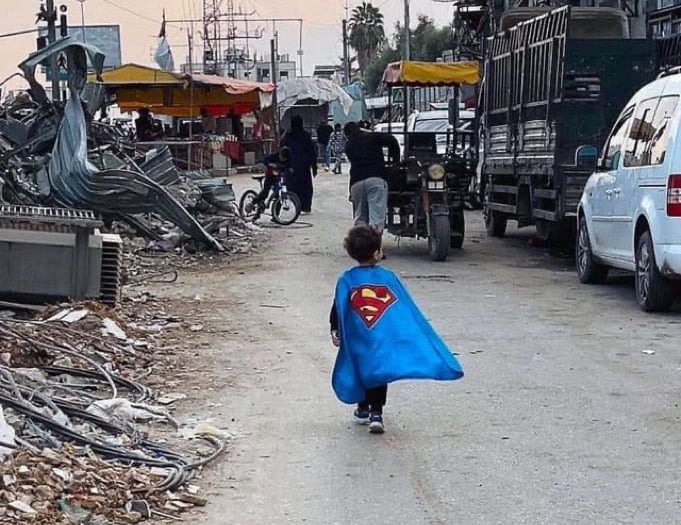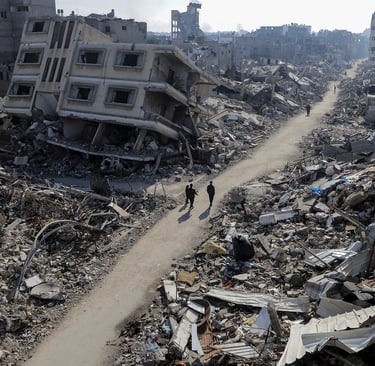A Superman in the Rubble: Gaza Child's Cape Becomes Symbol Amid Conflict and Film Boycott Calls
In the middle of Gaza's broken streets, a little boy walks through the rubble wearing a bright blue Superman cape. His surroundings are filled with shattered concrete, mangled steel, and the remains of homes that once held laughter, meals, and safety
IN BRIEF
Thinkbrief
7/17/20253 min read


In the middle of Gaza's broken streets, a little boy walks through the rubble wearing a bright blue Superman cape. His surroundings are filled with shattered concrete, mangled steel, and the remains of homes that once held laughter, meals, and safety. The cape, colored in red and yellow, flutters behind him as he moves quietly forward. He is small, barefoot, and alone yet somehow, he carries the weight of hope on his shoulders.
The photo has been shared across the world. For many, it captures the deepest contradictions of childhood and war. A child who should be playing among friends is instead walking through ruins. And yet, in that simple costume, there is a message: strength, imagination, and the belief in something better, even when nothing around him offers that assurance.
This image comes from Gaza, where the conflict between Israel and Hamas has devastated communities since October 2023. Airstrikes, ground operations, and blockades have left over 38,000 Palestinians dead, many of them children. More than 85,000 have been injured. Homes have vanished. Schools and hospitals lie in pieces. Even access to clean water and food has become a struggle. Famine now threatens over a million people, according to the United Nations. The suffering has become too vast for numbers to fully describe, yet somehow, a child in a cape says what statistics cannot.
While politicians argue and ceasefires stall, it is children like him who live with the consequences. Every day in Gaza is a day of survival, of grief, of not knowing whether the next moment will bring relief or more loss. And still, this child chooses to wear a symbol of strength. Not because it makes him safe, but because maybe it helps him feel brave.
At the same time this image began spreading, a different conversation was taking place thousands of miles away in Israel, where some are calling for a boycott of the upcoming Superman film Superman: Legacy. The reason isn’t the actors or the plot. The anger is focused on the film’s creative team director James Gunn and writer Ta-Nehisi Coates who have publicly expressed support for a ceasefire and for humanitarian aid to reach Gaza.
For many Israelis, particularly those who lost loved ones during Hamas’s October 7 attacks, such statements are painful. They see them as one-sided or dismissive of their suffering. In response, some right-wing voices and public figures have called for a boycott, saying the film is too political or anti-Israel. In that context, even Superman has become a source of division.
Meanwhile, pro-Palestinian activists have embraced the image of the Gaza boy in the Superman cape. For them, it speaks of resistance not armed resistance, but the quiet kind that comes from simply surviving and refusing to give up the dream of childhood. They see him not as a symbol of fantasy, but of reality a child who dares to imagine power in a place where he has none.
No one knows who the boy is. His name hasn’t been shared. But what he represents has become clear. He stands for all the children who have lost parents, siblings, and homes. He stands for those who have lived through more trauma by age ten than most adults will in a lifetime. Many of these children have never known a day without fear. They carry scars that no cape can cover.
To wear that cape in such a place is more than dress-up. It’s a way to say, even silently, “I’m still here.” It’s a way to feel strong when your world is falling apart. It’s a small act of imagination in a place where even play can be dangerous.
The photo has touched people around the world. Some see it as a heartbreaking portrait of innocence under siege. Others are inspired by the resilience it shows the quiet courage of a child who refuses to give up his dreams. Whether in Gaza’s streets or Hollywood’s studios, Superman is no longer just a fictional hero. He has become a mirror. Some see hope in that mirror. Others see pain.
But the child in the cape doesn’t know any of this. He isn’t making a political statement. He isn’t thinking about movie controversies or social media campaigns. He is just a boy. And like any boy, he wants to feel strong, protected, and free. That cape may be the only thing left that helps him feel that way.
In the end, his image leaves us with a simple, powerful question: who are the real heroes in this story? Is it the ones with power and armies, or is it the small boy walking through rubble, daring to believe in something more? Every child should live in a world where a cape is just a toy not a shield, not a cry for help, and not the last piece of hope they can hold onto.

